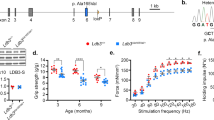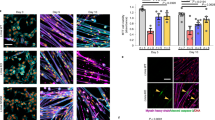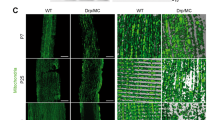Abstract
HUMAN X-linked Duchenne and Becker muscular dystrophies are due to defects in dystrophin, the product of an exceptionally large gene1,2. Although dystrophin has been characterized as a spectrin-like3 submembranous4 cytoskeletal protein, there is no experimental evidence for its function in the structural maintenance of muscle5. Current hypotheses attribute necrosis of dystrophin-less fibres in situ to mechanical weakening of the outer membrane6, to an excessive influx of Ca2+ions7,8, or to a combination of these two mechanisms, possibly mediated by stretch-sensitive ion channels9. Using hypo-osmotic shock to determine stress resistance10 and a mouse model (mdx)11,12 for the human disease, we show that functional dystrophin contributes to the stability of both cultured myotubes and isolated mature muscle fibres.
This is a preview of subscription content, access via your institution
Access options
Subscribe to this journal
Receive 51 print issues and online access
$199.00 per year
only $3.90 per issue
Buy this article
- Purchase on Springer Link
- Instant access to full article PDF
Prices may be subject to local taxes which are calculated during checkout
Similar content being viewed by others
References
Koenig, M. et al. Cell 50, 509–517 (1987).
Hoffman, E. P., Brown, R. H. & Kunkel, L. M. Cell 51, 919–928 (1987).
Koenig, M. & Kunkel, L. M. J. biol. Chem. 265, 4560–4566 (1990).
Cullen, M. J., Walsh, J., Nicholson, L. V. B. & Harris, J. B. Proc. R. Soc. B240, 197–210 (1990).
Slater, C. R. Curr. Opinion Cell Biol. 1, 110–114 (1989).
Karpati, G. & Carpenter, S. Am. J. Med. Genet. 25, 653–658 (1986).
Duncan, C. J. Experientia 45, 175–177 (1989).
Turner, P. R., Westwood, T., Regen, C. M. & Steinhardt, R. A. Nature 335, 735–738 (1989).
Franco, A. & Lansman, J. B. Nature 344, 670–673 (1990).
Menke, A. & Jockusch, H. J. neurol. Sci. (sup.) 98, 124 (1990).
Bulfield, G., Siller, W. G., Wight, P. A. L. & Moore, K. J. Proc. natn. Acad. Sci. U.S.A. 81, 1189–1192 (1984).
Sicinski, P. et al. Science 244, 1578–1580 (1989).
Koeltgen, D., Brinkmeier, H. & Jockusch, H. Muscle & Nerve (in the press).
Watkins, S. C., Hoffman, E. P., Slayter, H. S. & Kunkel, L. M. Muscle & Nerve 12, 861–868 (1989).
Jockusch, H., Friedrich, G. & Zippel, M. Muscle & Nerve 13, 551–555 (1990).
Partridge, T. A., Morgan, J. E., Gulton, G. R., Hoffman, E. P. & Kunkel, L. M. Nature 337, 176–179 (1989).
Jockusch, H. in The Dynamic State of Muscle Fibers (ed. Pette, D.) 429–443 (de Gruyter, New York, 1990).
Carnwath, J. W. & Shotton, D. M. J. neurol. Sci. 80, 39–54 (1987).
Foster, A. H. & Carlson, B. M. Anesthetics 58, 727–736 (1980).
Cooper, B. J. & Hamill, O. P. Soc. Neurosci. (Abstr.) 15, 412.5 (1989).
Ervasti, J. M., Ohlendieck, K., Kahl, S. D., Gaver, M. G. & Campbell, K. P. Nature 345, 315–319 (1990).
Blau, H. M. & Webster, C. Proc. natn. Acad. Sci. U.S.A. 71, 5623–5627 (1981).
Author information
Authors and Affiliations
Rights and permissions
About this article
Cite this article
Menke, A., Jockusch, H. Decreased osmotic stability of dystrophin-less muscle cells from the mdx mouse. Nature 349, 69–71 (1991). https://doi.org/10.1038/349069a0
Received:
Accepted:
Issue Date:
DOI: https://doi.org/10.1038/349069a0
This article is cited by
-
N-terminal titin fragment: a non-invasive, pharmacodynamic biomarker for microdystrophin efficacy
Skeletal Muscle (2024)
-
Duchenne Muscular Dystrophy: A Practice Update
The Indian Journal of Pediatrics (2018)
-
Mitochondria mediate cell membrane repair and contribute to Duchenne muscular dystrophy
Cell Death & Differentiation (2017)
-
Muscle satellite cells are functionally impaired in myasthenia gravis: consequences on muscle regeneration
Acta Neuropathologica (2017)
-
Activation of osmolyte pathways in inflammatory myopathy and Duchenne muscular dystrophy points to osmoregulation as a contributing pathogenic mechanism
Laboratory Investigation (2016)
Comments
By submitting a comment you agree to abide by our Terms and Community Guidelines. If you find something abusive or that does not comply with our terms or guidelines please flag it as inappropriate.



